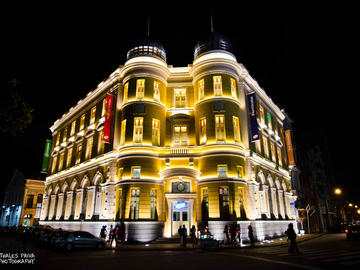Picture
More information on Caixa Economica Federal Museum

Description: Caixa Economica Federal Museum
Who passes through Cathedral Square always has an eye toward an imposing building whose facade boasts black granite Ionic colonnade surmounted by imposing too sober and classic pediment. The building is where the agency operates the Federal Savings Bank.
For a long time the place was the seat of the presidency of the box. With unification in 1971, it housed the headquarters of the São Paulo branch, until in 1979 he was transferred to the Avenida Paulista. Then, at the premises of the old office on the fourth floor, the museum was created, where they are preserved furniture, objects, machinery, photos and documents relating to the performance of Cash in Sao Paulo.
On January 12, 1861, Dom Pedro II signed the decree creating the 2723 Savings and Mount Relief Cut (Pledge). The two sheets of handwritten document signed by the Emperor and the Minister Angelo Muniz da Silva Ferraz, defined the ground rules for the operation of the new institution and was also their first regulation.
To start its activities, the National Savings and Monte Relief Court required an initial capital (or ballast) thirty contos as Item 2 of Decree 2723. After obtaining that amount, the company opened its doors on November 4, 1861, inside the Old Jail (Palacio Tiradentes) in the city of Rio de Janeiro, under the chairmanship of Viscount of Albuquerque.
Monte de Socorro (inspired by Montes Montes de Piedad Pious or European) represented a lifeline for the humbler classes of the population, lacked access to banking facilities, especially for loans. The loans were obtained with guaranteed jewelry and objects, with reasonable interest rates and terms for payment.
The savings also represented an important victory, because even the slaves could save their savings to buy a Freedom Charter.
On April 18, 1874, Dom Pedro II signed the Decree 5594, authorizing the installation of Savings Banks and Montes Relief in the provinces of the Empire. The first box was the Provincial of St. Paul.
The box was installed here by September 1, 1875. According to documents of the time, its beginning was very difficult. At that time, although inflation was not known, and who have money prefer to keep it at home, it was a safe place. Inside the mattress, the money did not flaunt wealth and was always on hand for any emergency. One of the most popular keepers of the old money São Paulo, José Joaquim dos Santos Silva, Itapetininga Baron, who was allowed the installation of EFC through a loan of 25 contos. Loan backwards, because it was given by Baron Box, serving for the installation of modest banking house there in the schoolyard and the first trade.
In 1905, the Fund earned its first headquarters, designed by architect Ramos de Azevedo and located in the street of the Cathedral, Wenceslas today Bras. Gradually, the building became cramped for their multiple needs. In 1934, when Samuel Ribeiro held the presidency of the CEF, was built the great edifice of the Cathedral Square, 111. Planned and executed by engineers and Long Albuquerque took five years to build, and was solemnly inaugurated on August 29, 1939 by President Getulio Vargas of the Republic.
This and many other stories can be discovered on a visit to the Museum of Caixa Economica Federal, which also raises the publicly available a library of over 40,000 volumes, among them many rare works.
Supportive culture and all artistic expression, the Fund has a fundamental role in the works that are now available to the public. In order to rescue the true icons of culture and national cultural heritage, the Museum of Cash today came to life and portrays the history of political, economic, artistic and cultural life of our country.
Address: Praça da Sé, 111, São Paulo SP
From Tuesday to Sunday from 9:00 am to 9:00 pm
Monday - Closed
Note: On holidays 09:00 am to 9:00 pm
More Photos of Picture

